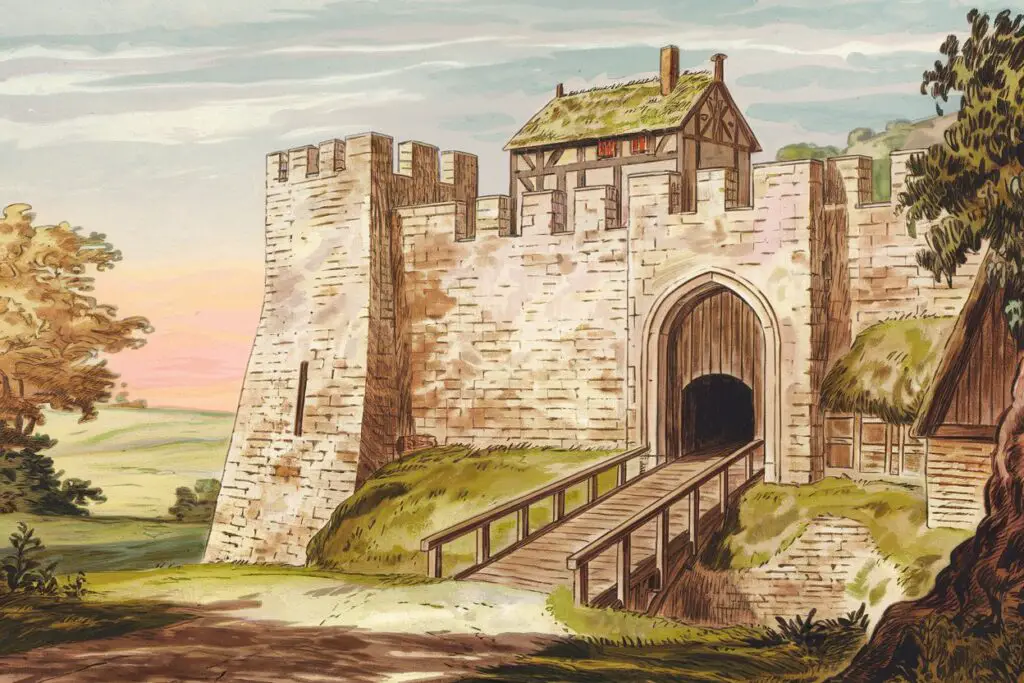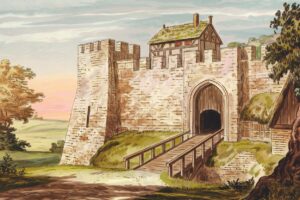Why Medieval Castles Were Built with Secret Escape Routes
Medieval castles were more than just grand stone fortresses—they were intricate defensive hubs designed with survival in mind. Among their many hidden features, secret escape tunnels played a crucial role in ensuring the safety of kings, nobles, and defenders during times of siege or sudden attack. These hidden passageways were not mere architectural embellishments but essential survival mechanisms, allowing rulers to flee undetected or launch counterattacks from unexpected directions.

One of the primary reasons for constructing these secret tunnels was emergency evacuation. If the castle walls were breached, the lord and his family needed a discreet exit to escape capture or execution. These tunnels often led to remote locations, such as dense forests, nearby rivers, or even secondary fortifications, ensuring that escapees could vanish without a trace. The Passetto di Borgo, a raised escape route in Vatican City, famously allowed Pope Clement VII to flee to Castel Sant’Angelo during the Sack of Rome in 1527.
Beyond escape, these hidden tunnels provided strategic military advantages. Defenders could use them to move troops undetected, launch surprise attacks on besieging forces, or smuggle in supplies during prolonged sieges. Sally ports, small concealed doors built into castle walls, were frequently used for these purposes. Dover Castle, known as the “Key to England,” had an extensive tunnel system carved into the chalky cliffs, originally designed for medieval defense and later repurposed during World War II for military operations.
Additionally, secret chambers and hidden rooms within castles served as secure hiding places for people and valuables. The priest holes of Tudor England, for example, were small, concealed spaces built to hide Catholic clergy from persecution under Queen Elizabeth I. Similarly, noble families often used hidden rooms to safeguard treasure, documents, or even political prisoners.
The presence of these secret tunnels also served psychological purposes. Attackers could never be certain whether defenders had an escape route or an alternative way to launch a counteroffensive, creating an added layer of uncertainty. In some cases, the mere rumor of a secret passage could deter invaders from attempting a prolonged siege.
Ultimately, secret escape routes were a testament to the ingenuity of medieval engineers and the ever-present need for security in a tumultuous era. Whether used for military strategy, emergency evacuation, or hiding precious assets, these hidden tunnels ensured that a well-fortified castle remained an unpredictable stronghold—even in the direst circumstances.
How Hidden Tunnels Helped Kings and Nobles Evade Capture
Throughout history, castles have been synonymous with strength and defense, yet even the most fortified strongholds could fall under siege. When walls were breached and betrayal loomed, secret tunnels often became the last hope for kings and nobles desperate to escape capture. These hidden passageways, ingeniously designed and carefully concealed, provided a crucial means of evasion in times of crisis.
Many medieval castles incorporated escape tunnels that led far beyond their fortified walls, offering a discreet route to safety. Some of these tunnels extended into dense forests, nearby villages, or even other fortified locations, ensuring that fleeing royals had a chance to regroup. One of the best-known examples is the Passetto di Borgo in Vatican City—a raised, fortified passage built in 1277 that allowed Pope Alexander VI to escape during Charles VIII’s invasion of Rome in 1494. It was used again by Pope Clement VII in 1527 when the city was sacked by imperial forces.
The design of these tunnels was anything but simple. Narrow, winding passages made pursuit difficult, while hidden entrances—often concealed behind fireplaces, bookshelves, or false walls—ensured secrecy. Some tunnels even incorporated architectural tricks, such as pivoting stones or disguised trapdoors, to prevent discovery. In Bran Castle, Romania, a secret passage hidden behind a fireplace connected different floors, providing a quick escape route—an essential feature in a fortress linked to Vlad the Impaler, the historical figure behind the Dracula legend.
Beyond their role in escape, these tunnels served additional strategic purposes. During prolonged sieges, they allowed defenders to sneak out and launch surprise attacks on besieging forces, a tactic frequently employed in medieval warfare. The sally port, a small, hidden exit in castle walls, was commonly used for this purpose. In other cases, tunnels facilitated smuggling, enabling besieged inhabitants to bring in food, weapons, and reinforcements without detection.
Despite their strategic value, not all hidden tunnels were well-kept secrets. Betrayal often led to their exposure, as seen in the case of Predjama Castle, Slovenia, where the rebel knight Erasmus of Lueg used a network of cave tunnels to evade a siege in the 15th century. He was ultimately betrayed by a servant, leading to his downfall.
Today, many of these tunnels remain shrouded in mystery, with archaeologists still uncovering lost passageways beneath ancient castles. Their existence speaks to the cunning and resilience of medieval rulers, who understood that even the mightiest fortress needed an escape plan.
Ingenious Designs—The Engineering of Medieval Escape Routes
Medieval architects were nothing short of ingenious when it came to designing secret escape tunnels in castles. These passages were not hastily dug last-minute exits; they were meticulously planned, structurally reinforced, and often integrated into the very foundation of the fortress. Some tunnels stretched for over a kilometer, carefully routed to emerge in dense forests, riverbanks, or even within nearby villages—anywhere that provided a discreet and defensible escape point. Castles like Muchalls in Scotland and the Bishop’s Palace in Exeter, England, are known to have had such hidden routes, ensuring that rulers and nobles had an untraceable way out in times of siege.
The construction of these tunnels required advanced medieval engineering techniques. Builders often carved the passages through solid rock or used stone masonry reinforced with wooden supports to prevent collapse. Concealment was paramount—entrances were hidden behind fireplaces, beneath trapdoors, or even within castle walls. Exits, too, were cleverly disguised, sometimes opening into cave networks or abandoned wells. To prevent flooding, tunnels were designed with slight inclines for natural drainage, and ventilation shafts were discreetly placed to allow airflow without revealing their location.

Security was another major consideration. Some tunnels featured defensive mechanisms like collapsible sections, false leads, or narrow choke points to prevent pursuers from easily following escapees. Moats and underground water channels were sometimes incorporated to deter enemy excavation attempts. The integration of these tunnels into a castle’s broader defensive strategy—alongside battlements, gatehouses, and fortified keeps—made them an essential, if secret, part of medieval military planning. Today, many of these tunnels remain undiscovered, buried beneath centuries of history, waiting for archaeologists to uncover their secrets.
Famous Castles with Secret Passages That Still Exist Today
Throughout history, castles have been more than just grand residences or military fortresses; they were strategic strongholds designed for survival. One of the most fascinating defensive features of many medieval castles was the inclusion of secret passages—hidden tunnels meticulously crafted to allow rulers, nobles, and defenders to escape sieges, smuggle supplies, or evade capture. Remarkably, many of these clandestine passageways still exist today, offering a glimpse into the ingenuity of medieval engineers.
Predjama Castle, Slovenia: A Fortress in a Cave
Perched dramatically within a cliffside, Predjama Castle in Slovenia is a marvel of medieval architecture. Built in the 15th century, the fortress was home to the rebellious knight Erasmus of Lueg, who used its secret tunnel system to outmaneuver besieging forces. Dug through limestone caves, this passage allowed Erasmus to smuggle supplies and launch surprise attacks—until he was ultimately betrayed and killed. Today, visitors can explore parts of these tunnels, offering a rare look into medieval siege warfare and escape tactics.
Bran Castle, Romania: The “Dracula” Passageway
Perhaps one of the most famous castles in the world, Bran Castle in Romania is often linked to the legend of Dracula. While its connection to Vlad the Impaler remains debated, its secret passage is very real. Hidden behind a faux fireplace, this narrow corridor connects the first and third floors, providing a discreet escape route. Discovered in the 1920s, this passage underscores the need for rapid, unseen movement within fortified structures—whether for defense or more clandestine purposes. (Perplexity Facts)
Coughton Court, England: The Priest Holes of Tudor England
During the religious tensions of the 16th century, Coughton Court, a Tudor estate in England, became a refuge for persecuted Catholics. The Throckmorton family, staunch Catholics, constructed priest holes—small, hidden chambers designed to protect clergy from capture during Protestant rule. These secret spaces, ingeniously concealed within walls and under floorboards, were a matter of life and death for those sheltering priests. Many of these hiding places remain intact, a testament to the dangers of religious persecution in Tudor England. (Google Arts & Culture)
The Passetto di Borgo, Vatican City: A Papal Lifeline
Not all secret passages were built for kings—some were designed for popes. The Passetto di Borgo, a raised corridor constructed in 1277, connects the Vatican to Castel Sant’Angelo, offering an emergency escape route for the Pope. It famously safeguarded Pope Alexander VI in 1494 and Pope Clement VII during the Sack of Rome in 1527. This passageway remains one of the most well-preserved examples of medieval escape architecture, still standing as a silent witness to centuries of political intrigue and danger.
Château de Najac, France: A Hidden Corridor for Nobles
Nestled in southern France, Château de Najac is a medieval stronghold that boasts a little-known architectural marvel—a secret passage leading from the chapel to the lord’s private quarters in the square tower. This hidden corridor was not only a defensive measure but also a symbol of noble privilege, allowing the castle’s ruler to move unseen. The existence of such passageways highlights the dual role of castles as both military bastions and centers of aristocratic power.
Harvington Hall, England: A Maze of Concealment
Few places in England contain as many priest holes as Harvington Hall. Built during the late 16th century, this manor house is riddled with hidden chambers designed to shield Catholic priests from Protestant authorities. These secret spaces were so well-crafted that some remained undiscovered for centuries. Today, Harvington Hall stands as a remarkable example of the lengths to which people went to protect their faith and evade persecution.
The Palace of Versailles, France: The Queen’s Secret Escape
Even the grandeur of Versailles concealed secret passageways. During the French Revolution, Marie Antoinette famously used a hidden door in the Queen’s Bedchamber to flee from an angry mob storming the palace in 1789. These concealed routes, though not designed for military escape, provided the royal family with a last resort when political unrest turned violent.
The Legacy of Hidden Tunnels
These castles and their secret passages reveal a universal truth—power and survival often go hand in hand. Whether used by rebellious knights, persecuted priests, or fleeing monarchs, these hidden corridors were more than architectural curiosities; they were lifelines in times of crisis. Today, they stand as silent witnesses to the dangers, intrigues, and ingenuity of the past, offering modern visitors a glimpse into the clandestine world of medieval escape.
How These Tunnels Were Disguised to Fool Enemies
Medieval architects and military engineers designed secret tunnels with remarkable ingenuity, ensuring they remained undetected by enemy forces. These hidden passageways were often camouflaged within the very fabric of the castle, blending seamlessly into its structure. Some entrances were concealed behind grand fireplaces, appearing as nothing more than decorative stonework, while others were hidden beneath false floors, accessible only by lifting inconspicuous wooden planks. In castles like Bran Castle in Romania, a secret passage was discovered behind a fireplace, leading from the first to the third floor—a design meant to provide an emergency escape route for occupants during an attack.
Ingenious locking mechanisms further obscured these tunnels. Some required activating hidden levers—such as moving a torch bracket or pressing a specific stone—to reveal the concealed entrance. The use of secret doors, known as Bab al-Sirr in Arabic architecture, was another method of deception. These doors were often built into walls and disguised by bookshelves or ornate carvings, making them nearly impossible to detect without prior knowledge.
Beyond architectural camouflage, natural landscapes played a crucial role in disguising escape routes. Some tunnels were constructed within existing cave systems or routed through underground rivers, ensuring they remained hidden from plain sight. Predjama Castle in Slovenia, for example, utilized a natural cave network to conceal a secret tunnel, allowing its occupants to withstand prolonged sieges while secretly resupplying.
Psychological misdirection was another tactic. Some castles featured multiple false tunnels or dead-end passages to confuse intruders who might discover an entrance. By the time an enemy realized they had been misled, the castle’s defenders would have already escaped through the correct route. These sophisticated disguises ensured that secret tunnels remained one of the most effective survival mechanisms for besieged rulers and nobles.
Legendary Escapes—Kings and Nobles Who Used Secret Tunnels
Throughout history, secret tunnels have been the last hope for kings, queens, and nobles facing capture or assassination. These underground passages, often hidden behind trapdoors or concealed in castle walls, played a crucial role in some of history’s most daring escapes.
One of the most famous examples is Pope Clement VII, who fled through the Passetto di Borgo during the Sack of Rome in 1527. As Charles V’s troops stormed the city, Clement VII used this elevated passageway to escape from the Vatican to the safety of Castel Sant’Angelo, ensuring his survival during one of the most violent attacks on Rome. Similarly, Pope Alexander VI used hidden tunnels in 1494 to evade invading French forces, demonstrating how these secret routes were critical for papal security.
In England, Mary, Queen of Scots, orchestrated a dramatic escape from Loch Leven Castle in 1568. Imprisoned by her political enemies, she disguised herself and slipped through a hidden passage, fleeing across the water to rally her supporters. Meanwhile, King Richard II is believed to have used a secret tunnel beneath Pontefract Castle in 1399 to evade capture—though his luck eventually ran out when he was later imprisoned and likely murdered.
Even in France, secret tunnels played a role in royal survival. Marie Antoinette attempted to escape the Palace of Versailles in 1789 as revolutionary mobs stormed the palace. Though her escape ultimately failed, her desperate attempt highlights the importance of these hidden routes for monarchs facing political upheaval.
Perhaps the most dramatic use of castle tunnels was by Erasmus of Predjama, the 15th-century Slovenian knight who defied the Habsburg Empire. During a siege of Predjama Castle, Erasmus used a secret tunnel—carved through the limestone cliffs—to smuggle in supplies and launch surprise attacks on his besiegers. His defiance lasted over a year, until he was betrayed and killed.
These stories reveal just how vital secret tunnels were in medieval and early modern history. Whether used by popes, queens, or rebellious knights, these hidden routes often meant the difference between life and death.
Were All Castle Tunnels for Escape? Other Hidden Purposes
When we think of hidden tunnels in medieval castles, the first image that comes to mind is often a desperate king or noble slipping away under cover of darkness, evading besieging forces. But were all of these tunnels really designed for dramatic escapes? Not quite. While secret passageways did serve as emergency exits, their purposes were far more diverse and, in some cases, even more intriguing.
One of the most significant alternative uses of castle tunnels was military strategy. Some tunnels were designed for counter-mining operations, where defenders would dig their own tunnels to intercept and collapse those of attacking forces. This tactic was crucial in sieges like the 1215 siege of Rochester Castle, where King John’s forces successfully undermined the castle walls by setting fire to wooden supports beneath them. In response, defenders often built their own tunnels to detect and disrupt enemy mining efforts before they could cause structural damage.
Beyond warfare, tunnels also played a critical role in storage and logistics. Castles required vast amounts of food, water, and weaponry to sustain prolonged sieges. Underground chambers provided temperature-controlled environments for storing grain, wine, and other perishables. Some tunnels even connected directly to nearby rivers or wells, ensuring a continuous water supply during times of crisis.
Additionally, tunnels were used for communication and clandestine movement. Nobles, spies, and messengers could travel unseen between sections of a castle or even to external locations. In some cases, tunnels connected castles to monasteries or churches, allowing religious figures to move discreetly or hide persecuted individuals. The Passetto di Borgo in Vatican City, for example, allowed popes to flee from the Vatican to Castel Sant’Angelo in times of danger.
Trade and economic factors also played a role. Some castles had tunnels leading to nearby towns, facilitating the movement of goods and people without drawing attention. These passageways were particularly useful for avoiding taxation or political restrictions on trade.
Perhaps one of the most fascinating uses of secret tunnels was their role in espionage and intelligence gathering. Hidden listening posts allowed castle defenders to eavesdrop on enemies, while concealed chambers provided safe spaces for diplomatic negotiations away from prying ears.
While the idea of a daring escape through a hidden tunnel is undeniably romantic, the reality is that these subterranean passageways were far more than mere escape routes. They were crucial elements of medieval military, economic, and social infrastructure—testaments to the ingenuity of castle architects and the complex realities of life in a fortress.
How Archaeologists Are Uncovering Lost Medieval Passageways
For centuries, medieval castles have held secrets beneath their stone foundations—hidden tunnels, forgotten chambers, and clandestine escape routes. Today, archaeologists are using cutting-edge technology to uncover these lost passageways, revealing the ingenuity of medieval engineering and the strategic minds of castle builders. But how exactly do researchers locate tunnels that have been buried for centuries?
One of the most powerful tools in modern archaeology is ground-penetrating radar (GPR), which sends electromagnetic waves into the earth and detects anomalies beneath the surface. At Sforza Castle in Milan, researchers employed GPR and laser scanning to map subterranean structures, uncovering secret tunnels that had been hidden for centuries. Similarly, infrared thermal imaging is being used to detect temperature differences in walls and floors, often revealing hidden doorways or bricked-up corridors.
Historical documents and architectural blueprints also play a crucial role in these discoveries. At Sforza Castle, sketches made by Leonardo da Vinci, found in Codex Forster I, provided crucial clues about the existence of underground tunnels. Meanwhile, at Culzean Castle in Scotland, archaeologists conducted radiocarbon dating on charcoal samples from a hidden cave, revealing that the site had been occupied as far back as 135-325 A.D.
By combining these high-tech methods with traditional excavation, historians are piecing together the lost history of medieval strongholds. With many castles still standing today, who knows how many more hidden tunnels remain undiscovered beneath their stone walls?
Could There Be Undiscovered Tunnels Beneath Castles Today?
The idea that medieval castles might still conceal hidden tunnels beneath their foundations isn’t just the stuff of legend—it’s a real possibility that archaeologists are actively exploring. Many castles, particularly those with a history of sieges or royal intrigue, were designed with secret passageways for escape, communication, or military strategy. But given the sheer complexity of these structures and centuries of modifications, some tunnels remain undiscovered to this day.
Advancements in technology are breathing new life into the search for these lost passageways. Ground-penetrating radar, 3D laser scanning, and thermal imaging are allowing researchers to peer beneath castle floors without disturbing the ancient stones. At Sforza Castle in Milan (Perplexity facts), for example, experts from the Polytechnic University of Milan used these techniques to uncover hidden cavities just below the surface—suggesting that similar methods could reveal long-lost tunnels elsewhere.
Historical records also guide these explorations. Some medieval blueprints and royal documents reference secret routes that have yet to be found. In certain cases, folklore and oral histories have turned out to be surprisingly accurate—such as the discovery of hidden corridors in Bran Castle in Romania (Google Arts & Culture), long rumored to have a concealed escape passage.
Dover Castle, known for its extensive wartime tunnels, is another prime example. While many of its underground routes have been mapped, some remain unexplored due to structural instability or lack of access (Expeditions). Given the castle’s long history—from medieval fortifications to World War II command posts—it’s plausible that additional tunnels, built for different strategic purposes, are still waiting to be discovered.
As research continues, castles around the world may yet reveal more of their hidden secrets. Whether for military defense, royal escape, or clandestine meetings, the tunnels beneath these fortresses remind us that history is still unfolding—sometimes just below our feet.
The Fascination with Castle Secrets in Modern Media and History
There’s something undeniably thrilling about secret tunnels in medieval castles. Maybe it’s the idea of hidden passageways beneath centuries-old stone, or perhaps it’s the tantalizing possibility that history still holds undiscovered secrets. Whatever the reason, these concealed corridors have captivated audiences for generations, making their way into literature, film, and even video games. Castles like Bran Castle in Romania—often linked to Dracula—have fueled both historical curiosity and pop culture myths, drawing hundreds of thousands of visitors each year who want to see the real-life inspiration behind the legend.
Beyond fiction, secret passages remain a major draw for tourism. Castles such as Edinburgh Castle and Château de Chambord actively promote their hidden tunnels as part of guided tours, inviting visitors to step into the shoes of medieval rulers and spies. Meanwhile, historians continue to uncover new passageways, like the one found in the Palace of Versailles, which Marie Antoinette used to escape an angry mob during the French Revolution. These discoveries keep the public’s imagination alive, reinforcing the idea that history is never truly finished—it’s just waiting to be uncovered.
Even in modern storytelling, secret tunnels symbolize intrigue, power, and survival. Historical documentaries, period dramas, and even video games like Assassin’s Creed use these passageways to enhance narratives, blending real history with adventure. It’s no wonder that castles with hidden tunnels remain some of the most fascinating historical sites in the world—because who doesn’t love a good secret?







